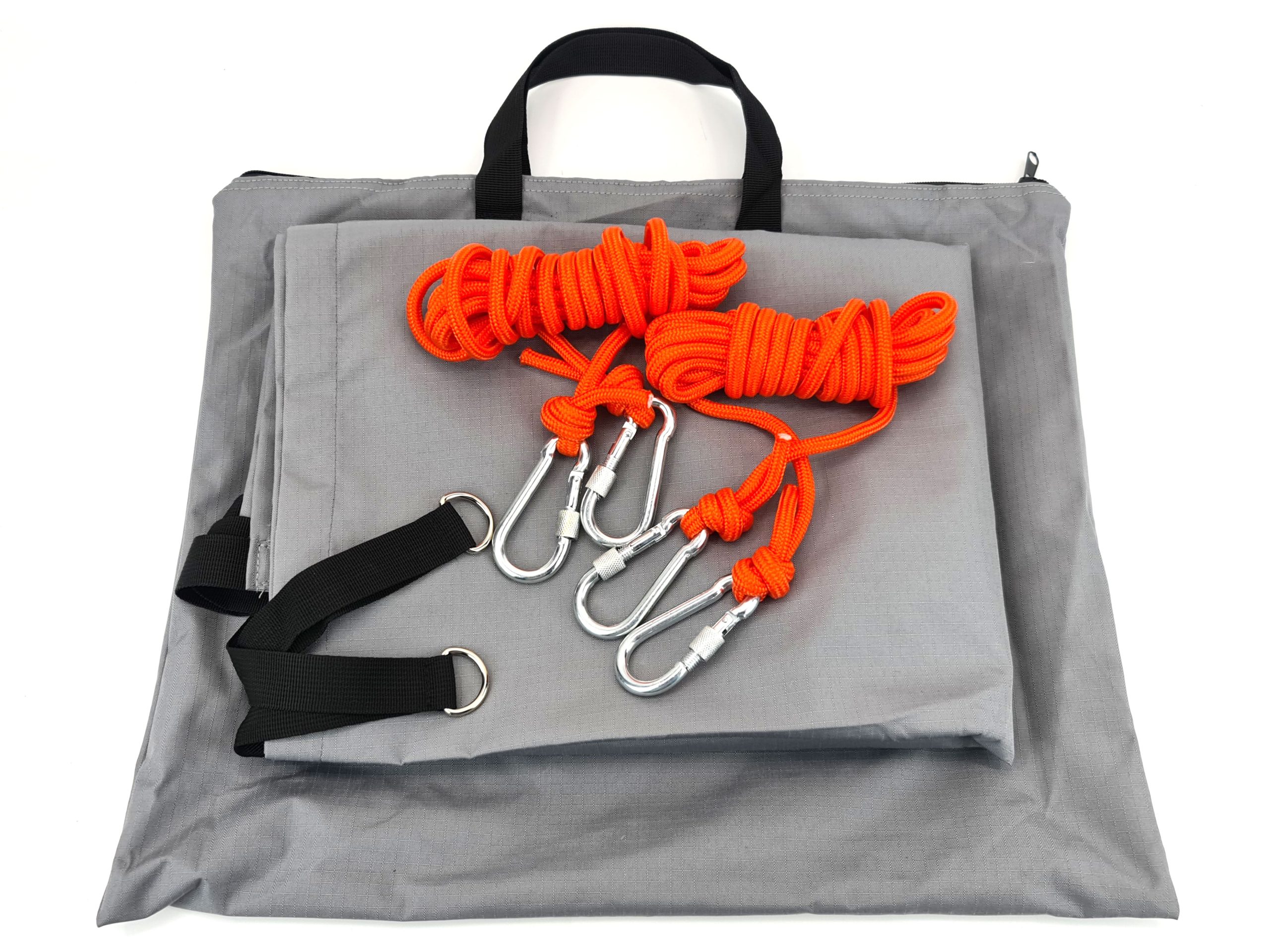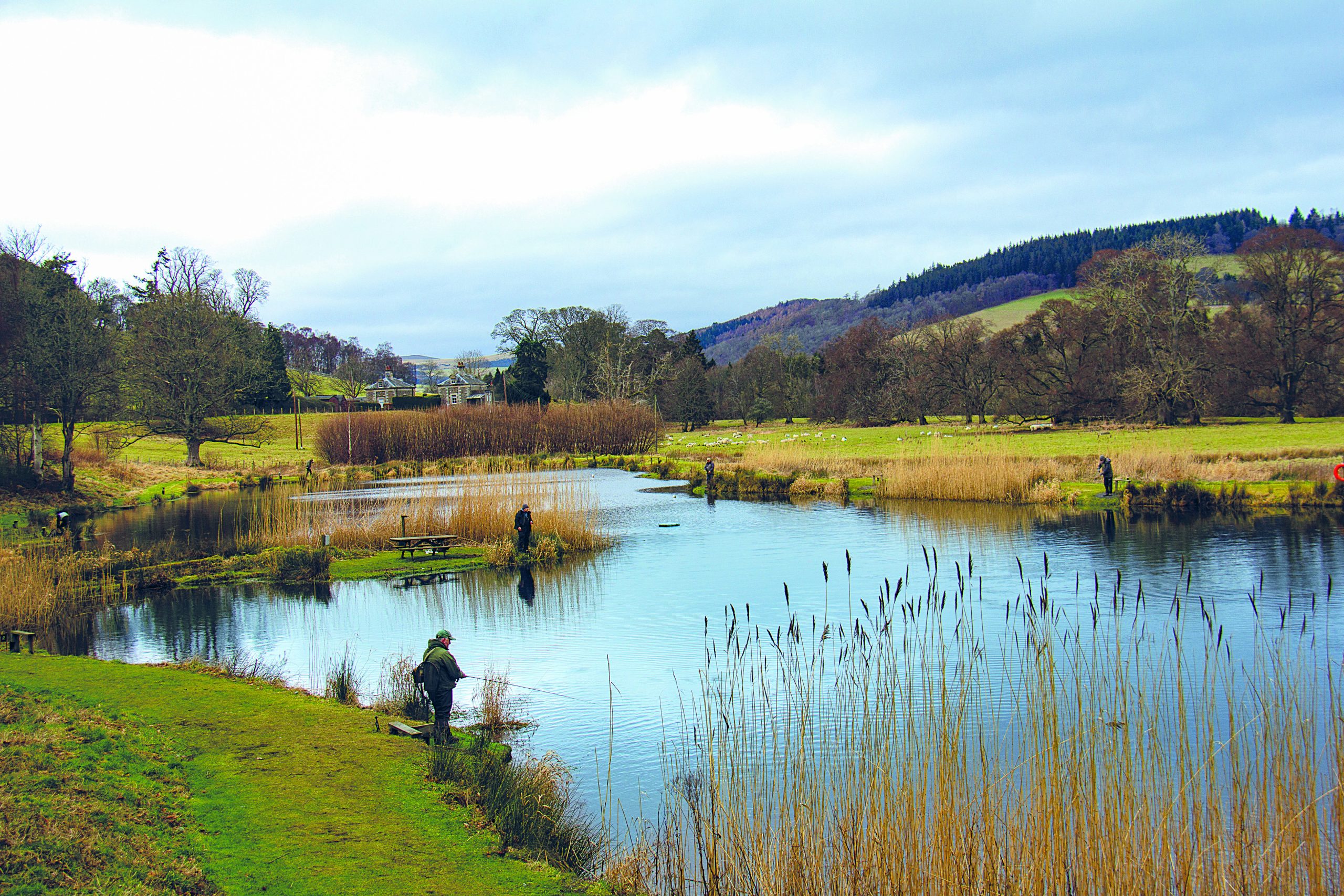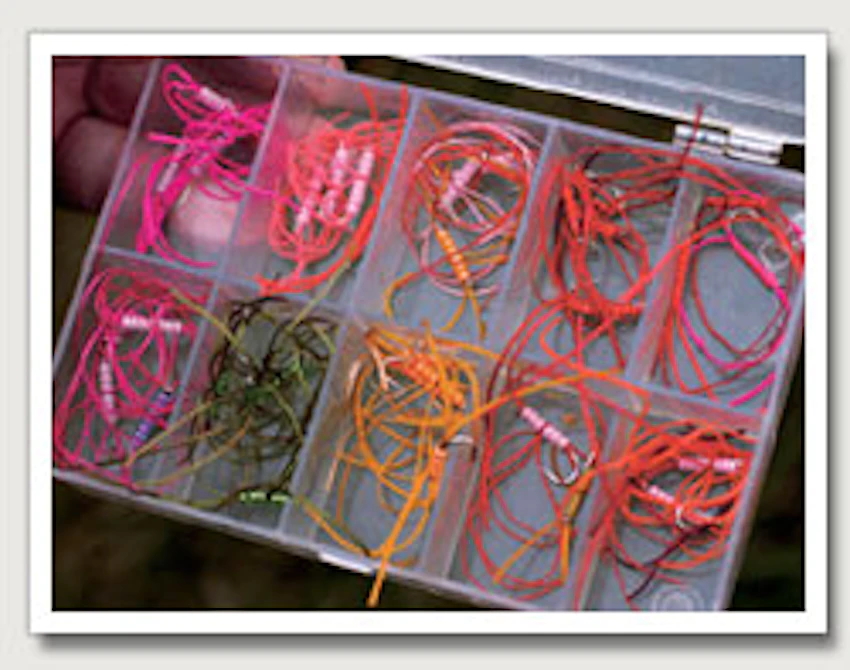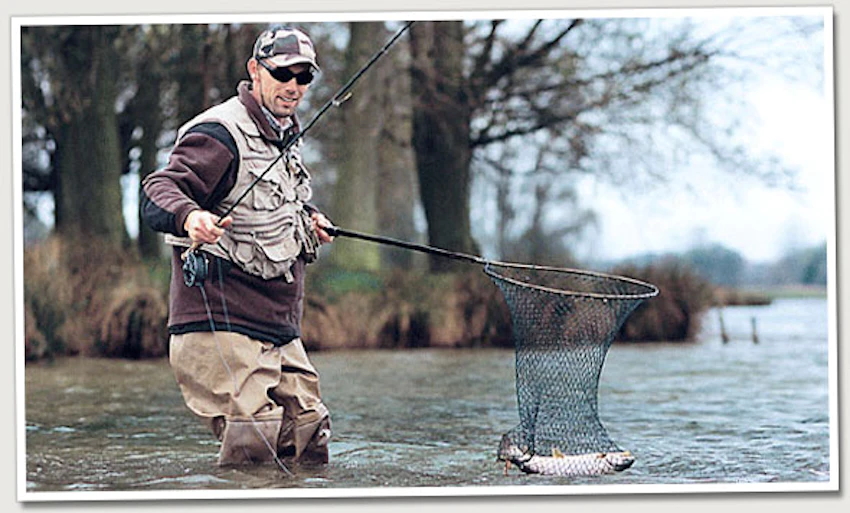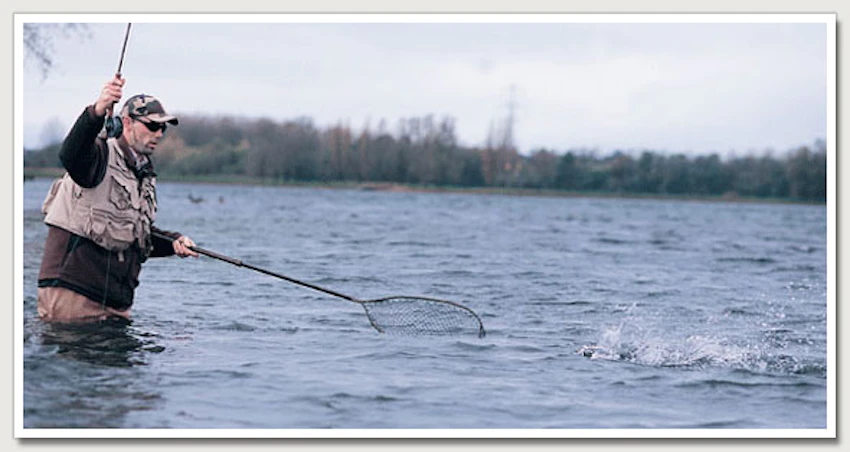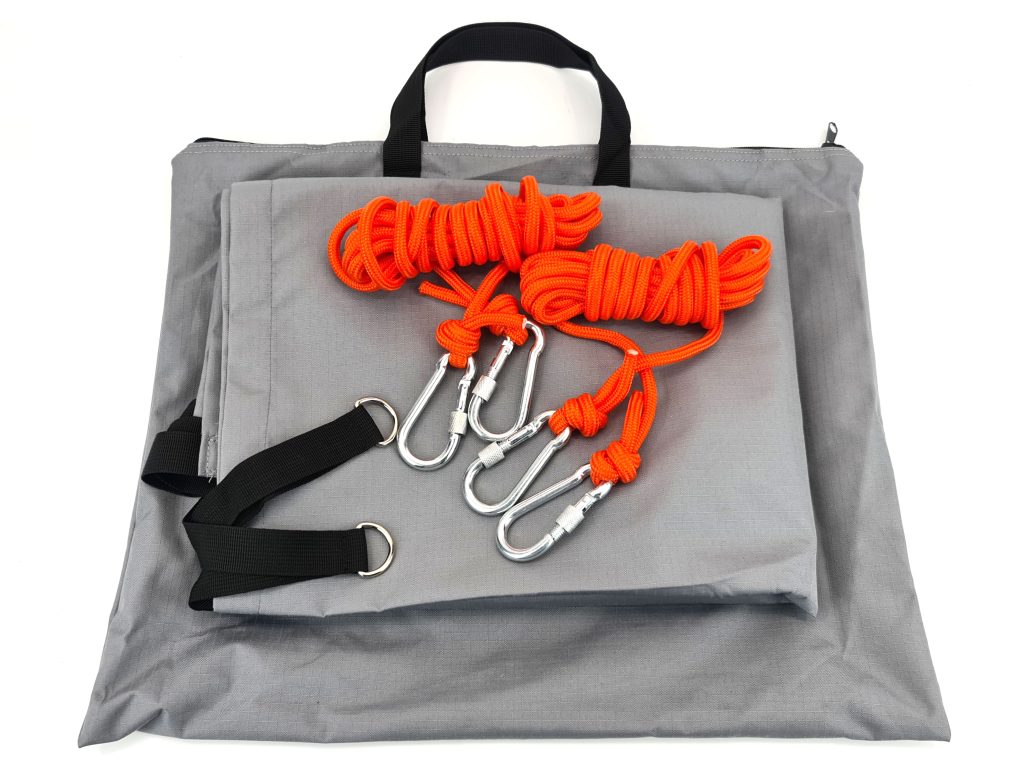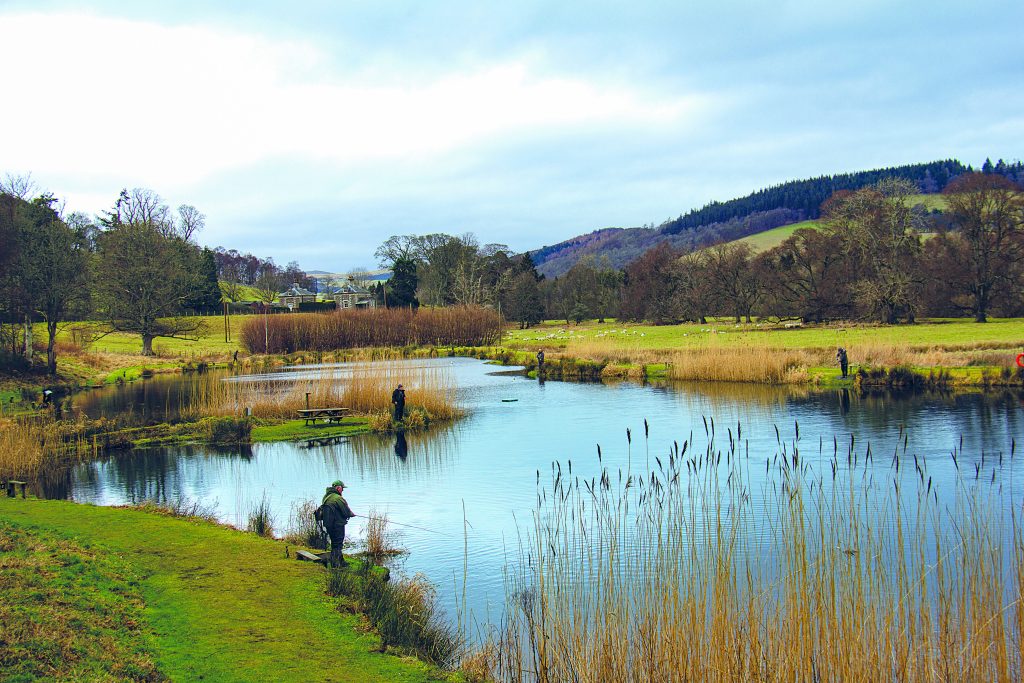HOW TO FISH A BLOODWORM PATTERN
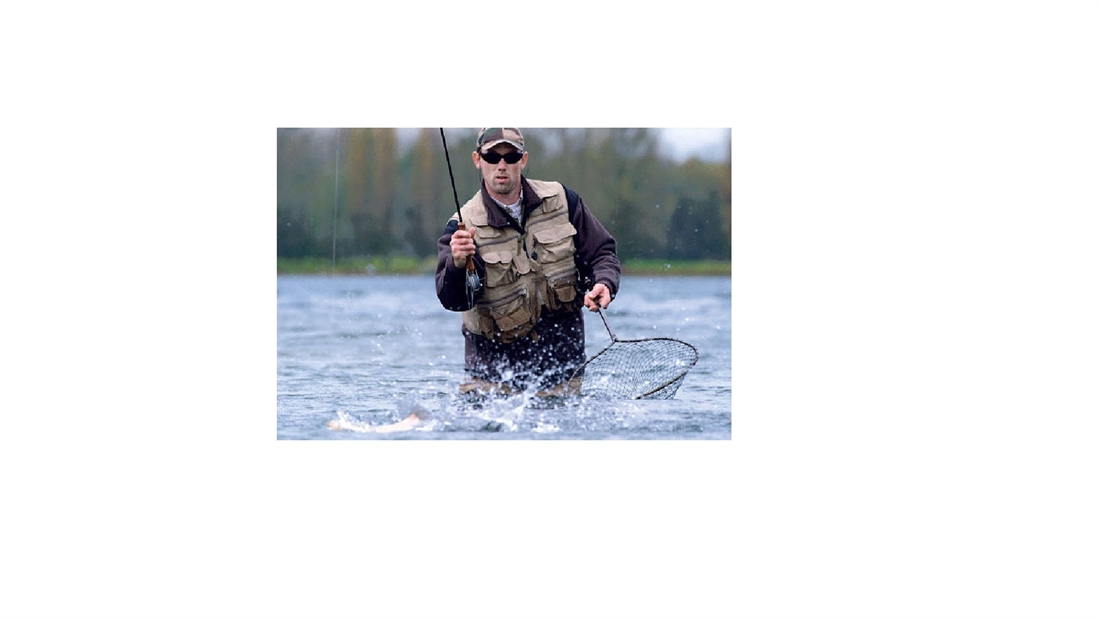
Maran Kingfisher captain Fred Bainbridge unleashes his team’s deadly new bloodwormbased pattern on the Elinor trout
A SHEET of low clouds, driven along by a stiff westerly wind, threatens rain. Northamptonshire’s Elinor Trout Fishery does not look particularly inviting this breezy grey November morning but to the locals who visit the water week after week, it’s the action under the water that counts.
This autumn Elinor has never fished better. Weeks of warm winds have kept the water temperature around a fish-happy 10 degrees and the trout feeding. Flies have been hatching later than anyone can remember and even dries have been working, particularly the Daddy.
Because so many fish are released at Elinor, the residents are no pushover. They’ve seen every fly that swims. And on some days, each trout comes to a different pattern. But there’s one fly they are unlikely to have seen before… the spidery-legged, bead-bodied bloodworm-based pattern on the end of Fred Bainbridge’s leader.
Fast-talking Fred, and his two Maran Kingfisher team mates Peter Appleby and Chris Micallef, love fishing Elinor, despite the 300-mile round trip down the A1 from their North-East homes. For the past two years the three-man squad has dominated the water’s Airflo/ CEFF National Stillwater Final, winning the event comfortably both as a team and as individuals.
And although they have a number of “secret” flies still under wraps in their armoury, they claim it’s the Yellow Worm, and its colour variations, that gives the team that real competitive edge on small stillwaters.
A development of the original scarlet Apps’ Bloodworm, the new version uses tiny sewing beads on the body to create a more fishalluring profile underwater. But it’s those waving Flexi-Floss legs that the trout can’t seem to resist, particularly in clear water.
“We’ve developed versions in three colours,” explains Fred.
“We’ve found that the Pink Worm really sorts out the freshly-stocked fish. The Olive Worm works on resident fish, while the Yellow Worm is a great all-rounder.
“A great deal of time and innovation by Pete, Chris and myself has gone into creating these patterns. Their pulsating movement in the water is the key to success.
“The construction of the fly is a careful balance between the beads and the legs, which must be tied with perfectly-straight Flexi-Floss.
This makes the fly ideal for fishing with an intermediate line. And because the beads are more or less weightless, they allow moderately good turnover when casting.
“Although the pattern will catch fish all year, this fly is particularly deadly in winter on small stillwaters when the water is clear. We’ve found that the amber colour works as a trigger point. Expect savage takes.”
STIFF WIND
TO DEMONSTRATE the fly’s fish-attracting qualities, Fred has returned to Elinor to refish the swims that brought him second individual place in the Airflo National Stillwater Final. His first choice is the corner of the dam close to a bank of willows where a deep hole attracts stockies and resident trout alike.
This is a swim that produced well for him in the Final when other anglers were struggling. But today a stiff head wind is blowing into this corner, so Fred is forced to shorten his leader from his usual 22ft down to 16ft to cope with the breeze.
“As a general rule, the further you can cast the Worm the better,” explains Fred. “Fish will often follow the fly for some distance before taking. Many of the takes will come halfway back. In a competition situation, I’d use two worms of different colours to see which one the trout preferred.”
The odd fish is moving well out in the wave but even with the Loomis GLX-Distance rod, Fred is struggling to show them the deadly Worm. The southerly bank with a helpful side wind looks more inviting. So we move.
Elinor is renowned for its crystalclear water which today has a tinge of suspended colour created by wading anglers. Fred wades out to where the water becomes clearer and punches out the yellow version of the Flexi-Floss-legged fly.
Believing the fish to be lying slightly deeper in the morning, Fred starts with his favourite Greys “depth finder” line with a medium sink rate of 2.5-3.5in per second. This is a line that can be fished slow or fast to work the fly at various depths.
In the heavy wave, we can see nothing moving. But Fred is convinced that there are fish lying deeper and counts the Worm down to sink through the water levels.
Fred likes to mix up his retrieves from a straight pull through to a fast figure-of-eight with little jerks in between. He keeps the tip of his rod low to watch for the slightest sign of a take.
How will the Worm perform?
After just three casts, Fred has hooked his first trout. But it proves to be a triploid brown trout. Fred’s face shows his disappointment. He’s convinced that the rainbows are out there.
An awkward weed bed in front of Fred means he can’t let the fly go as deep as he would like. And with no line tray to keep the sinking line out of the water, he can’t push the flies out as far as normal. But the next cast sees the line tighten and a silver rainbow clear the water.
“Now we’re getting somewhere,” he smiles as he steers the trout into the net. As Elinor is a catch and release water, Fred has pressed the barb down on the hook and is able to remove the fly with ease without touching the fish.
“To thread the beads on the hook you have to press down the barb anyway,” says Fred.
RIGHT RETRIEVE
TO GET the Worm’s legs pulsing in the water, the right retrieve is vital. “One day long pulls will be working. On another day, short jerks will be more effective. It’s up to the angler to experiment,” says Fred.
Today it seems to be long pulls with substantial pauses in between, to induce a take from an interested fish. But it’s important to keep checking the fly to make sure that all the legs are working. After taking a few fish, those legs can start to tangle.
Fred senses that the rainbows are starting to respond and ups his game, fishing the water in front of him like a machine. Two more rainbows follow on consecutive casts. The fly is working its magic.
Elsewhere along the bank, other anglers are catching spasmodically.
Although the odd rainbow is now starting to show in the wave, tempting them is proving difficult. But Fred is on a roll and rainbow follows rainbow to the net.
After just a couple of hours’ fishing, Fred is into double-figures – despite losing a few on the way.
Now the rainbows are starting to rise higher in the water, sometimes bow-waving behind the fly, so Fred switches to a slower-sinking intermediate line. “The way the fly moves in the water makes them angry,” laughs Fred. “That’s why the takes can be so fierce.”
The next trout to the net is a sleek fully-finned resident trout around 3lb, the type of fish for which Elinor is rightly famous. Again, it can’t resist the pulsations of the Yellow Worm.
“Any reader who is fishing a Troutmasters qualifier this winter needs this fly in their box,” stresses Fred. “It’s just that good, particularly when the water is clear and cold.”
The strong wind has made line control difficult during the day. Fred admits that he would like to have fished his flies slower and picked out more takes on the drop.
Moving fish seem to indicate that the rainbows are no deeper than six inches from the surface. “They don’t want the fly static or pulled fast, just somewhere in between,” says Fred.
Trout are now rising almost under the rod tip, a novelty for Fred whose previous trips to Elinor have been solely for matches or practise when the trout are pushed well out.
So for light relief, we challenge Fred to catch a fish on a dry.
On goes a size 8 Black and Green Hopper — the fly he used to win the Yorkshire Boat Championship on Stocks Reservoir — and before long a rainbow trout has sucked it down.
“Cracking place is this,” grins Fred as he releases his final trout of the morning before retiring to the lodge for a well-earned cuppa. He’s taken 16 trout on the Yellow Worm in a blitz attack on the water.
Fred’s rapid-fire success with the trout has attracted the attention of other anglers, who are curious to see the fly that is so seductive.
Burton Latimer angler John Bosworth’s remark when shown the novel pattern is a typical reaction – “what the hell is that?”
John reveals that he has not had a touch all morning, so he has more than a passing interest in a fly that can attract so many fish.
Fortunately, Fred is happy to share the secrets of the Yellow Worm with his fellow anglers.
LEFT HANDER
ON the far side of the fishery, Fred’s flyfishing mentor “Big” John Sutton has located a shoal of trout moving up and down the weedbed in a shallow bay.
The stiff westerly wind would make this spot difficult for a conventional right-handed caster, but John has had to teach himself to cast left handed after a horrific industrial accident seriously damaged his right arm.
Starting off with a Zorro lure suspended a couple of feet under an indicator did not produce the expected results for John, but the Olive Worm fished on a floater once again proves irresistible to more than a dozen trout.
Captain of the Titan Loch- Style team, it was John who first encouraged Fred to take up competition fishing. He now works tirelessly to encourage as many young anglers as possible to take up flyfishing.
Keen to try the Worm in as many swims as the wind allows, Fred heads for the boat dock area where he quickly takes another fish. It’s then two more trout from the dam as the light fades.
By now the wind has finally dropped away to nothing and Fred slows the retrieve right down to match the mood of the fish. In the Small Water Final, Fred took a double-figure fish. And he’s still hoping for something similar today.
Then right on dusk in shallow water, he hooks a fish on the Yellow Worm that bolts away for the middle. But sadly it comes adrift.
But Fred is sanguine. He’s enjoyed a tremendous day’s sport and demonstrated just how deadly the Yellow Worm can be.


